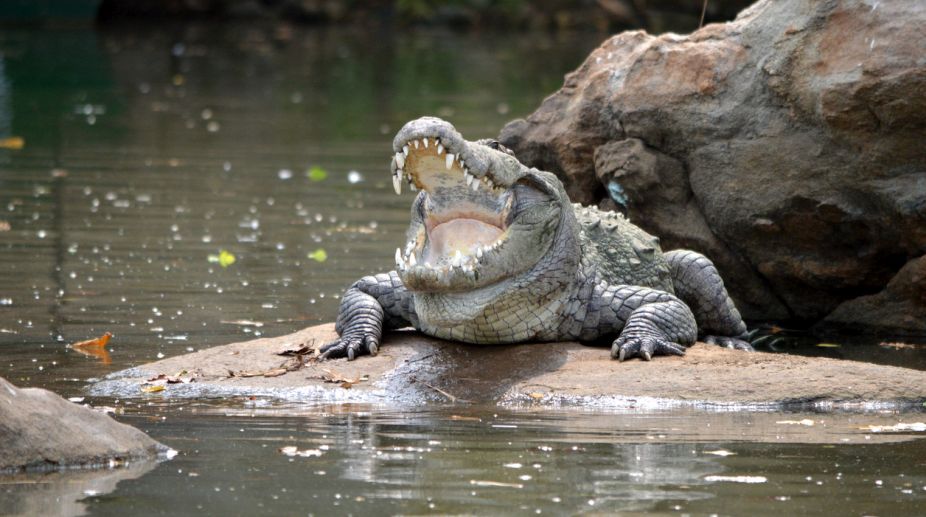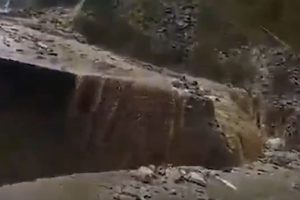Recently I spent three days in Srirangapatna, an island in the Cauvery long noted for its crocodiles and historic associations. As a boy I saw here, in the course of an afternoon, a dozen of these huge reptiles basking on sand-pits and on the flat-topped rocks jutting out of the water, but on this visit, though I kept my eyes wide open I saw only one small eight feet crocodile, and though I saw it twice, it was so wary and shy that I could not get within a hundred yards of it for a picture.
All over India, but perhaps even more in the South than in the North, the mugger has become either locally extinct or quite rare in the past generation and though it is one of our most interesting animals, no one seems to regret its passing — except those who fancy crocodile leather shoes and bags and cannot possibly afford them any longer.
Incidentally, only the skin of the belly and the sides of a crocodile can be converted into leather, and the animal is extremely difficult to shoot with the certainty of recovery of its carcass, factors that have contributed to the current steep prices of the cured skin.
The mugger, as district from the fish-eating gharial with a thick disc at the tip of its slender, elongated snout, is the crocodile of peninsular India, south of the Ganges and the Indus.
I am not sure of this, but I believe the much more dangerous estuarine
Crocodilus porosus is considered a race distinct from the crocodiles of our inland waters, though both are “mugger”in many Indian languages and in vulgar English.
The classic definition of a mugger was provided to WT Hornaday, an American naturalist who spent two years studying India’s fauna in 1877-78, when he inquired of an English-speaking Bengali what precisely a mugger was, “It lives in the water” he was told, “and eats both males and females”!
In the old days, muggers had a certain defence value, and were often to be found in the deep moats of important forts; at Srirangapatna. I was told that muggers guarded the old fort in the days of Tippu Sultan, and there are historical records of their existence in the moat of the Vellore fort.
Old-time accounts of these dreaded sentinels devouring incautious cattle and humans who had fallen into the moats, tearing them to pieces and bolting the still quivering flesh in a churning frenzy of competition for food, are no doubt imaginative, actually, when, feeding on large prey, crocodiles like them high and soft and cache the bodies of their victims under water till they are soft enough, but of course it can make little difference to the victims whether the brutes start on their meals immediately or awhile later.
Crocodiles are among the most fascinating of all reptiles, for all the gruesome legends about them. Taxonomically, they are distinct from the lizards to which one might think them closely related — in fact, lizards are nearer to the snakes than to the crocodiles. Crocodiles have a heart similar to ours in possessing two distinct ventricles, though it is curiously angular in shape and much more enduring than ours; a crocodile’s heart continues to function long. Long after death, and it is wise to make quite sure that the mugger one has shot is well and truly dead before attempting to skin it.
Unless effective steps are taken to assure them of sanctuary, our muggers will probably be extinct in another generation. They are even now much hunted wherever they are to be found, and are singularly unpopular in the neighbourhood of the fish-breeding centres established in some of our hydel projects.
Actually if one could breed muggers in India, as alligators are bred in America, the enterprise would be richly rewarding, especially as crocodile leather has a very high export value. It would be no easy undertaking, of course, and will need to be started on an extensive scale for hope of success, but then much helpful knowledge can be acquired at the alligator breeding centres of America, for after all the two animals are not so very different. The one thing that can be said firmly about this speculation is that if it is ever to be attempted in our country, now is the time; in another 20 years the project will be impossible, because all our crocodiles would have vanished by then.
This was published on 13 November 1967











